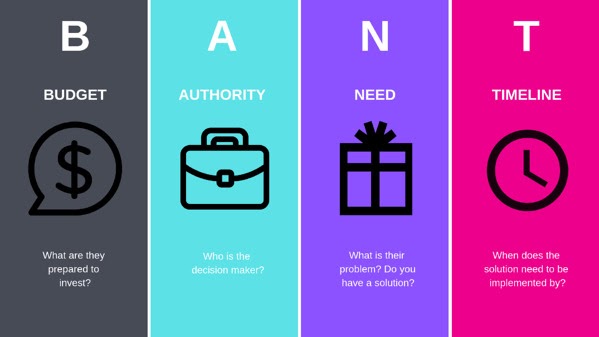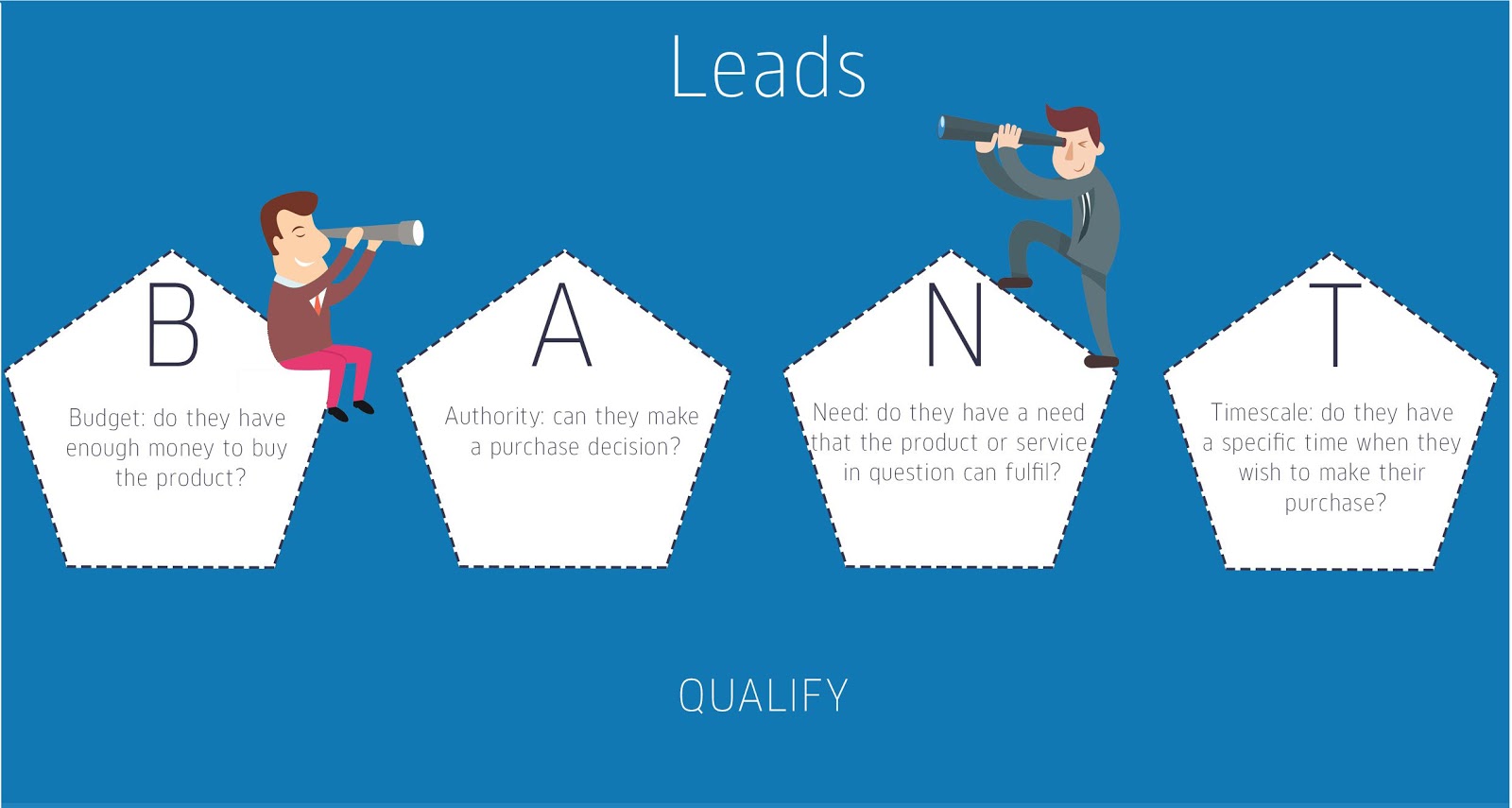What is BANT? 4 Key Aspects of BANT Sales Process
The Lead evaluation process is the stage that determines whether a potential customer is worth the time and effort you invest in them. It’s an effective way to determine if a prospect is really interested in the sales opportunity you’re offering them.
In fact, each of us, when deciding to buy a certain product or service, asks ourselves questions like, “Is there something that makes me want to spend time?” “Is its price appropriate?” We are reviewing and evaluating information to decide if the sales opportunity offered by the seller is worth a try.
So, with the sales consultant, how to analyze the potential customers that the company sets out to build a long-term and loyal customer relationship is always difficult? The BANT sales evaluation process strategy can be a powerful tool for determining whether a Lead is successful.
So in today’s article, I will introduce you to What BANT sales pricing strategy is and how it will change the way you sell product.
What is BANT?

Firstly, let’s find out what the BANT sales evaluation process strategy is.
BANT is considered as a traditional method including sales method and lead determination process. BANT stands for budget, authority, need, and time. BANT is a sales quality assessment method that allows salespeople to determine whether a potential customer is suitable for their budget, purchasing capacity, product needs, and timing of the purchase. BANT was originally created by IBM with the aim to quickly identify the contacts most likely to purchase.
As far as the evaluation process framework is concerned, the BANT is quite simple and it will mainly consider the following:
-
Budget: Does Leads have enough budget to buy your product?
-
Authority: Does Lead have enough authority to make purchasing decisions or does it need to be through other people and organizations to buy?
-
Needs: Are your products and services suitable for Lead’s needs?
-
Timeline: When and how long does Lead want to buy?
If a Lead can meet at least three of the four BANT criteria, then the lead is considered viable and a potential customer. However, the sales team can consider and decide how Lead is feasible for them. Usually, leads are determined by BANT, the most important factor is their financial ability. If a prospect does not have the budget for the product you are selling, they may not be qualified opportunities.
The Lead standardization process saves sales team time and energy by eliminating impossible opportunities and concentrating resources on customers with high purchasing potential. Leads are identified in many different ways: email acquisition, phone number, referral, advertising, and other digital marketing techniques. However, whether a customer has given you their email address or subscribed to your newsletter does not mean they will become your leads.
After gathering background information from the customer, if the opportunity seems viable, ask more questions to gather more in-depth information. Here are some additional questions to consider when using a BANT for lead determination.
Budget
-
Do you have a dedicated budget for buying new technology? How much is that budget?
-
Is the budget currently shared with any other departments?
-
If you can’t figure out your budget limit, what do you do?
Authority
-
Do we need to include other people or organizations in our discussion?
-
Do you currently use any similar products to ours? Did you anticipate any overlaps?
Need
-
Tell me about the problems you are having. How long has that been?
-
Do you currently have a plan to address these issues?
-
If so, what do you think will prevent you from implementing that plan?
Timeline
-
What are your priorities in problem-solving?
-
When do you try to solve your problem?
-
How long will it take to solve the problem?
Depending on the Lead and their business, your contact may have more than one person. Very few businesses operate alone, they often collaborate to share resources. This can be an advantage for you by tailoring it to best suit the situation.
It is worth noting that the implementation of the BANT process does not have to be in order. If the leader’s time is your top priority, you can completely follow the TBAN process. When a customer needs an urgent solution that meets the need for a budget alternative, you can implement an NBAT solution. You can prioritize the order of abbreviations in any way you need to best suit the needs of your potential customers.
Read more:
- What is Residual Income? Residual Income vs Passive Income
- What are the 7 steps in the sales process?
- 15 Best Ecommerce Unique Selling Proposition Examples!
- 17 Best Upselling Techniques
The Four Key Aspects of BANT Sales Process

For any salesmen who are not knowledgeable with BANT, the terms of budget, authority, need, and timing may seem like irregular words. Consequently, to disentangle your comprehension of BANT, let us further investigate the essential phrasings that structure the mainstays of the BANT deals strategy and how they direct the use of BANT in lead capability.
1. Budget plan: The worth set by the possibility for your administration
A possibility set their spending plan dependent on different contemplations. For a few, it could be the valuation that they have shown up upon their own assessment, while others may arrive at a figure on reaching your rivals. Here and there, having no financial plan could imply that the possibility esteems the administration over the financial plan. In any case, the equivalent could likewise show their non-reality as a purchaser.
Henceforth, asking non-meddling, thoughtful inquiries identified with your possibility’s financial plan could give you a knowledge into what they look for and what you offer at a set expense. Possibilities can at present be prevailed upon on the off chance that they float around the expense of your administrations, yet in the event that it’s anything but a match completely, it is ideal to look for different leads.
2. Authority: Identifying the key leaders
Some of the time, your sales rep may straightforwardly contact the dynamic position, while most occasions, they may begin at the base of the bar and should work their direction upwards the levels of leadership. BANT questions permit you to get a thought of who gets the opportunity to have the last say while settling on the choice. Normally, just on the grounds that your contact isn’t the dynamic authority implies that you totally quit cooperating with them!
Notwithstanding understanding the key supporters and champions that assume an indispensable job in deciding, it helps in understanding the dynamic cycle. Such data can enable the salesman to utilize methodologies and strategies that help the business exertion. Realizing when to state what and to whom could administer how well you can steer the results in support of yourself.
3. Needs: Discovering the requirement for your item as an answer
The arrangement between the difficulties confronted and torment focuses experienced by your possibilities with the viability of your item as an answer chooses the requirement for your contribution. Henceforth, it is fundamental that you profoundly investigate the need, as expressed by the possibility, and set aside the effort to break down and get them.
When you, as a salesman, have examined the torment focuses and recognized the difficulties faced by the possibilities, you will have a thought on the best way to situate your administrations as an answer for these issues. After understanding the necessities of the possibilities, you can qualify the possibility, however, you can likewise hold a vital position that permits you to pitch your item and close the deals adequately.
4. Timing: Timeline of when the possibility plans on revealing the arrangement
Some of the time, you may go over a situation where a possibility is an ideal fit. Your item is in accordance with the arrangements they look for, you are on an acceptable footing with the endorsing specialists, and the spending plan has been worked out. In any case, the circumstance is somewhat off. A short timetable may make it difficult for your association to respect the possibility’s solicitation, while a cutoff time that is excessively far off may give the appearance that the possibility recognizes your item or the cycle as a need.
Hence, it is imperative to set away from either party regarding timetables. After knowing an achievable timetable, you can progress in the direction of the social affairs and distributing assets as the deal finishes.
These activities permit consistent progress from deals to the conveyance of your item, which upgrades consumer loyalty. Henceforth, the timetable likewise includes a critical factor while qualifying possibilities.
Ordinarily, the BANT deals philosophy is utilized as a second step in the business cycle. Driving through unpretentious, yet open-finished inquiries can assist you with landing BANT-Qualified leads without burning through your time, assets, and endeavors on pursuing impasses. BANT qualifies leads based on your contributions and the possibility’s necessities relying upon four conclusive variables.
The Pros and Cons of BANT

1. Pros
Generally, BANT can be applied to all different types of buyer personalities, so it is a way for sellers to easily implement it at most sales organizations. Whether you work for a manufacturing company or in a dealer marketplace, the rules are broad enough to apply to the types of functional customers your company wants to do equally.
Moreover, establishing a formal framework for your company or organization to follow helps to ensure everyone is working on the same platform. From there you can evaluate the quality of work and come up with solutions to improve the quality of the customers who are likely to pass through your sales funnel.
2. Cons
The BANT method has been created for a long time. Although it has been tested, operated, and shown to be effective however one fact that it seems to have been out of date. There are also some opinions that BANT is too focused on sellers and not focused on many functional buyers. When digital sources become available, buyers have to do most of their research before filling out the charting affiliate system and becoming full-fledged customers. This means that they want to explain to the sales manager why they are eligible to buy but they may be rejected by the BANT category questions.
How to Qualify Leads with BANT

It can be seen that BANT plays a quite important role in identifying potential customers for companies. However, not everyone knows how to properly use BANT to assist in reviewing and setting standards with potential customers. Here are some ways that can help individuals and businesses implement BANT effectively.
1. Budget plan: Do you have the funds for the necessary solutions?
The budget is always your first worry about finding qualified leads. On the off chance that you were a vehicle vendor, your first inquiry when somebody strolls onto your parcel would be about spending plan, correct? You will never introduce a Ferrari to someone with a 1000$ budget. At the point when customer’s possibility doesn’t have the financial plan for your item/ administration and it is highly unlikely around it, the arrangement won’t work out. It’s a central dealbreaker in the business capability measure.
Inquiries to pose
-
What amount would you spend on comparative items/administrations?
-
Who is responsible for monetary choices?
-
What amount of cash is planned for this arrangement?
2. Authority: Learn about customer’s decision-making proccess
With regard to dynamic, most organizations don’t have a top-down methodology.
Today, there are two unique gatherings engaged with the dynamic cycle who are the Decision-creators and Advocates. The Decision-producers is the person who will eventually settle on the decision and sign the desk work. Promoters are the ones who will do the exploration, settle on the decisions, and pass the data onto the leaders.
Also, that is not all. Chiefs and promoters frequently concede finishing clients to settle on choices since this current gathering’s upfront investment drives selection.
At the point when you’re assessing a business increasing speed device, you have to comprehend your reps’ ability. Don’t simply think about it from a large scale down view, yet take a gander at the client level, as well. Will it stay with your group? Part of why Yesware works here is our reps have become tied up with the worth.
What it implies: Instead of concentrating on one individual, discover the promoters and end-clients, as well.
Inquiries to pose
-
What is your dynamic cycle?
-
How might I assist you with living up to your desires?
-
Who in your group would utilize this arrangement? What are their qualities? Impediments?
3. Needs: Evaluate the necessary level of customer needs
All things considered, you have to remember you’re not selling, you’re taking care of issues. In case you’re sitting around pitching your item or administration to a client who doesn’t generally require it, it won’t end well.
Ideally, you wind up offering to somebody who needn’t bother with the item/administration. They end up despondent in light of the fact that you burned through their time and broke their trust. A straightforward method to measure your possibility’s requirement for your answer? Get clinical. Ask them how much their agony focuses on trouble them on a size of 1 to 10. Possibilities who rate their torment between 7 to 10 are your top.
Inquiries to pose
-
What does your present cycle resemble?
-
Where do you run into obstacles?
-
What issues would you say you are attempting to understand by seeing arrangements like our own? How frequently do you run into those issues? What amount do they trouble you on a scale from 1 to 10?
4. Timing: Find out when your customers are ready to use your service
In the business capability cycle, timing and straightforwardness go inseparably.
There shouldn’t be any shocks: It’s significant that you have an away from when your possibility will be prepared for your item or administration. The main concern is knowing their planning causes you to gauge your planning for first-contact to change.
In the event that their timetable is longer than your normal deals cycle and the income does not merit the pause, you’ll need to return to the open door when the circumstance is correct. To measure this, you have to comprehend 2 meanings of the customer’s purchasing stage and the criticalness that drives that time span.
Inquiries to pose
-
How long have you been searching for an answer?
-
What sorts of time imperatives would you say you are working with?
-
What are the suggestions on the off chance that you don’t meet the timetable?
-
Are there any agreements from different arrangements you’re now marked to? Until when?
Related posts:
- How To Calculate Profit Margin?
- Inside Sales vs Outside Sales
- What is the Foot-in-the-door Technique?
- Types of Distribution Channels
Conclusion
BANT is a decent benchmark for capability. It’s a decent pattern to get a snappy hit of what is new with a possibility and in the event that they will be a solid match. How you take it to the following level is by including different inquiries to get a comprehension of why.
BANT has endured through the ages since it’s viable when utilized effectively, noteworthy, and relevant to a scope of items, value focuses and deals measures. Adjust it to your circumstance, at that point mercilessly focus on the best fits.
Hope the information that I provide above has helped you partly understand about What is BANT and how to use it appropriately in the sales process.
New Posts






